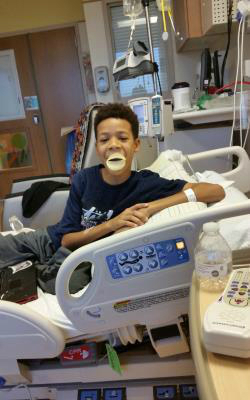
Chris's Story

 In September 2015, 13-year-old Chris Jordan fell on his side while playing soccer in gym class. Chris experienced lingering pain in his right arm, and his parents took him to their family doctor who diagnosed a hairline fracture. While his mom, LaShawn, cautioned Chris to take it easy for a while, her typically easygoing son complained of recurring pain again in November.
In September 2015, 13-year-old Chris Jordan fell on his side while playing soccer in gym class. Chris experienced lingering pain in his right arm, and his parents took him to their family doctor who diagnosed a hairline fracture. While his mom, LaShawn, cautioned Chris to take it easy for a while, her typically easygoing son complained of recurring pain again in November.
“On November 15, the Sunday after his birthday, I noticed he had swollen lymph nodes,” LaShawn said. “Probably eight of them popping out of his neck,” she continued. “When my kids are catching a cold, I might see one or two, but I knew something (bigger) was coming with this.”
When his pain continued, Chris’s family thought his appendix might be the cause, and they took him to the emergency department at a nearby hospital. A series of tests revealed that Chris’s blood contained blast cells – a common marker of acute leukemia.
On Thursday, November 19, Chris arrived at Children’s National Health System, where doctors confirmed that he had acute lymphoblastic leukemia (ALL). While ALL is a common form of childhood cancer, Chris was considered a high-risk patient because of his age.
“It initially felt like someone had just punched me in the stomach,” LaShawn said. “But after we got settled in our room, it was just peaceful. Everyone was just very calming. Chris asked me, ‘Does this mean I have cancer?’ I said yes, but I knew everything was going to be fine.”
Chris’s mom said they prayed continuously over the following days, and on the Monday after his diagnosis, they began aggressive, inpatient chemotherapy treatment for a month.

“We attacked the cancer with multi-agent chemotherapy,” explained Anne Angiolillo, M.D., Chris’s primary oncologist and Director of the Leukemia and Lymphoma Program at Children’s National. “By the end of inpatient therapy during the first month, Chris was in remission and his bone marrow aspiration showed no signs of leukemia.”
In addition to the excellent medical care Chris received, LaShawn expressed thanks for the emotional support his care team provided. “They don’t see the cancer. They don’t see the tubes. They don’t see the bald heads. They just see the kids,” she said.
LaShawn added that the care team continuously made their family feel like Chris was the most important patient in the hospital, and she knows they do the same for other parents and their children too.
Dr. Angiolillo said that Chris made it easy, noting, “He’s always absorbing all of the information we share, and he’s always grateful and sweet.”
Chris returned home in time for Christmas, and even went back to school at the end of January where he earned a place on the honor roll. While he continues to receive chemotherapy, Chris and his family are planning for the future. He is expected to enter the maintenance period of treatment with more self-care administered at home this fall. But, the date on everyone’s minds is March 2019.
“I tell everybody, put it in your phone,” LaShawn said. “Chris’s last day of chemo is March 21, 2019. He’ll be ringing the bell (signifying the end of treatment). He’ll be 16.”
